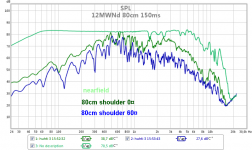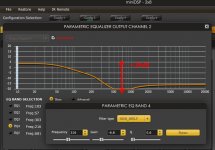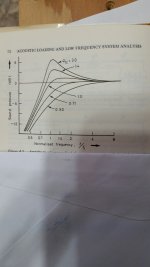It's possible to get OB bass. Its even possible to do it with one driver a side, if you've got a baffle.
Adding a baffle increases the cancellation path length, pushing down the -10dB point. Double the path length, and you've pushed the cancellation down an octave, or gained 6dB of headroom higher up.
Now, I used a 15" a side OB, with ~600mm wide baffles, and EQ'd flat to 25Hz. The result was pretty good, but SPL at the bottom end was limited of course. Definitely enough for a home HiFi though. If I took out the baffle, I'd probably lose around 10dB of bass, so I'd need 3 or 4 naked 15" drivers a side to match that again.
I'd recommend you simply experiment. What's enough for me might not be enough for you. I expect an 18" a side on some kind of baffle to be enough for most domestic listening. If you wanted to go baffle-less, figure out how many dB you're losing going from baffle to no baffle, and make it up again with cone area.
Chris
Adding a baffle increases the cancellation path length, pushing down the -10dB point. Double the path length, and you've pushed the cancellation down an octave, or gained 6dB of headroom higher up.
Now, I used a 15" a side OB, with ~600mm wide baffles, and EQ'd flat to 25Hz. The result was pretty good, but SPL at the bottom end was limited of course. Definitely enough for a home HiFi though. If I took out the baffle, I'd probably lose around 10dB of bass, so I'd need 3 or 4 naked 15" drivers a side to match that again.
I'd recommend you simply experiment. What's enough for me might not be enough for you. I expect an 18" a side on some kind of baffle to be enough for most domestic listening. If you wanted to go baffle-less, figure out how many dB you're losing going from baffle to no baffle, and make it up again with cone area.
Chris
Personnaly, i wouldnt even think of doing 60-70hz and downward using OB. I'm having 8-12db EQ boost @ 24-31hz on 4x 10W7 in sealed boxes...
It's tonal balance vs punchy slam etc ! Have a too big driver, even the voice will be not so natural ! 6" to 8" seems to work above 150 Hz !
I think one can start by looking for highest Sd/Mms (cm²/grams) ratio rather than nominal sizes, which don't tell much...
There is few drivers out there that reaches almost 10 sq.cm per gr. (or even exceed it) and i think even the big ones (such as the Faital Pro's) have the articulation to compete against the smaller 6 & 8'' midwoofers, while having better chances to deliver good results in the 100-500hz region.
That would be my next bet, anyway... 😎
i'll replace my jack-of-all-trades Volt 10'' midbass for a 18FH500 or 15PR400 and i think i'll upgrade for both more energy and finesse.
Personnaly, i wouldnt even think of doing 60-70hz and downward using OB. I'm having 8-12db EQ boost @ 24-31hz on 4x 10W7 in sealed boxes...
Think I ended up with around 27dB of boost at the bottom end. Hitting ~300w peaks on the 15"s, too.
Chris
Think I ended up with around 27dB of boost at the bottom end. Hitting ~300w peaks on the 15"s, too.
Chris
wow, 27db of boost. I'm not even sure my DEQX allows me to do that. miniDSP plug-ins are limited to 16db i think.
Anyways, you have to reduce all other ways, thus limiting your total output, no ?
In my book, if i have to go north of 14-15db of boost, i consider a change of design.
even if your driver's Xmax/Xmech allows it, you're kind of swimming against Niagara's current by boosting the first octave in OB config, no ?
I mean, there is no traction, really 😱
Unless you have a baffle large enough, of course.
I mean, there is no traction, really 😱
Unless you have a baffle large enough, of course.
@ ScottL
Well, I don't suggest a baffle-less (aka nude) driver system for the woofer but it works well for higher bands, e.g. above 500Hz. Up to 500Hz you can have a 12" driver in a modestly sized planar baffle and that will provide sufficient output to support an 80Hz or 100Hz low end to the passband.
I know this because I have built a couple of OB systems following this principle and it works well. I use a 12 inch diameter woofer in a 17 inch wide, 30 inch tall baffle and with boost to compensate for the OB losses the response reaches down to below 100Hz. The mid and tweeter are "nude" on a stalk projecting above the baffle.
OB "bass" below 80Hz or so requires some different approaches, but down to 80-100Hz it's not a big challenge at all as long as you choose the driver and baffle size correctly.
Well, I don't suggest a baffle-less (aka nude) driver system for the woofer but it works well for higher bands, e.g. above 500Hz. Up to 500Hz you can have a 12" driver in a modestly sized planar baffle and that will provide sufficient output to support an 80Hz or 100Hz low end to the passband.
I know this because I have built a couple of OB systems following this principle and it works well. I use a 12 inch diameter woofer in a 17 inch wide, 30 inch tall baffle and with boost to compensate for the OB losses the response reaches down to below 100Hz. The mid and tweeter are "nude" on a stalk projecting above the baffle.
OB "bass" below 80Hz or so requires some different approaches, but down to 80-100Hz it's not a big challenge at all as long as you choose the driver and baffle size correctly.
Charlie,
How much XMax do you need from your 12" for your bass boost at 80/100 Hz ? >10 mm ?
DOes it work with any Qts ? Or you choose PA driver with Qts above 0.5 ?
There is a sympathetic Faital but it's a 10" : FaitalPRO | LF Loudspeakers | 10FE200
Look at the relativ low Le and the relativ high Qts : should be punchy in an OB (but low Xmax and Sd !)!
Which is worryng me with these OB for the upper bass low mid is the fact you have more cone moves, so less rapid damping to serve the dynamic and micro détails, no ? And also because the bass boost adds more thermal feature (not good for the phase, change the Qtc ?) ! Now can we ear it or not is another story !
How much XMax do you need from your 12" for your bass boost at 80/100 Hz ? >10 mm ?
DOes it work with any Qts ? Or you choose PA driver with Qts above 0.5 ?
There is a sympathetic Faital but it's a 10" : FaitalPRO | LF Loudspeakers | 10FE200
Look at the relativ low Le and the relativ high Qts : should be punchy in an OB (but low Xmax and Sd !)!
Which is worryng me with these OB for the upper bass low mid is the fact you have more cone moves, so less rapid damping to serve the dynamic and micro détails, no ? And also because the bass boost adds more thermal feature (not good for the phase, change the Qtc ?) ! Now can we ear it or not is another story !
Last edited:
Charlie,
How much XMax do you need from your 12" for your bass boost at 80/100 Hz ? >10 mm ?
DOes it work with any Qts ? Or you choose PA driver with Qts above 0.5 ?
There is a sympathetic Faital but it's a 10" : FaitalPRO | LF Loudspeakers | 10FE200
Look at the relativ low Le and the relativ high Qts : should be punchy in an OB (but low Xmax and Sd !)!
Which is worryng me with these OB for the upper bass low mid is the fact you have more cone moves, so less rapid damping to serve the dynamic and micro détails, no ? And also because the bass boost adds more thermal feature (not good for the phase, change the Qtc ?) ! Now can we ear it or not is another story !
The 12" driver I use has 9mm of Xmax, which is about what is needed in that setup to reach 80-100Hz. The Q and Fs of the driver do enter in the equation, because they prescribe the driver's own rolloff around resonance. You do not need a high Qts driver. The one I use has around Qts=0.4 or 0.5 or so. A prosound driver with low Q (e.g. 0.3 or less) is not helping you even with its increased passband SPL because the free air low end is drooping badly when the Qts is low. So I look for home audio drivers with Qts of at least 0.4, and these are not uncommon.
The other concerns you mentioned are not really a factor for me. If you boost power there will be more heat generated, but at the same time the large excursions and free air will likely improve cooling a bit compared to a closed box. A pro driver would be better in this regard, but finding one with high enough Qts and low enough fs for this application is nearly impossible.
Thanks Charlie for this inputt.
I surmise also there is an aesthetic choice in the way OB sounds here.
As it's always a trade off and we can not reproduce the original sound as a photograph can NOT capture the reality either but a view of it only, one has to choose what he likes the most !
I surmise also there is an aesthetic choice in the way OB sounds here.
As it's always a trade off and we can not reproduce the original sound as a photograph can NOT capture the reality either but a view of it only, one has to choose what he likes the most !
Is high Qts really mandatory for OB/naked ?
Got very good results with 0.35 lately...
Qts is only important around resonance. Low Qts in OB just adds the droop of the driver response to the OB losses. It certainly can work with boost, no doubt. But when you compare what is needed with a low Qts driver of higher sensitivity with a lower sensitivity higher Qts driver sometimes the higher Qts driver is actually better suited to the task. At some point you need so much additional power that it is getting less practical. This is all folded into the question of where the low end of the driver's passband will be located. Choosing this point to be higher in frequency reduces excursion demands and there will be lower boost demand as well. I typically run a number of scenarios and then think about what makes sense for the driver I choose to employ. I look at what volume displacement will be needed to reproduce some low frequency in an OB system, based on how large I want to make the baffle. Then I look at my driver options to see if they are capable of that Vd. Then I look at the free air frequency response of the driver to see the additional losses that I can expect. Some iterating around these factors is used to figure out the tradeoffs. Cost is a factor at some point as well.
and by ''high/low'' Qts, what exactly are we talking about ?
less than 0.3 = low and more than 0.4 = high ?
less than 0.3 = low and more than 0.4 = high ?
wow, 27db of boost. I'm not even sure my DEQX allows me to do that. miniDSP plug-ins are limited to 16db i think.
Anyways, you have to reduce all other ways, thus limiting your total output, no ?
In my book, if i have to go north of 14-15db of boost, i consider a change of design.
Here a nude 12" driver's unequalized response and correction curve from minidsp, 150W power available. xo is 170Hz LR2 to a closed-box subwoofer, I don't want to try to get low bass from OB.
My experience suggests that MartinLogan hybrids' xo LR4 around 300Hz must be problematic. Too high and too steep xo to get smooth integration of different radiators/polar patterns/room response.
Attachments
and by ''high/low'' Qts, what exactly are we talking about ?
less than 0.3 = low and more than 0.4 = high ?
There's the Qts of the driver, that you start with. Depending upon the application, said total system Q will increase by a certain degree. If there is
NO LOAD on the driver, the Q stays the same.
Final system Q is a matter of taste.
A Q of .707 is considered maximally flat, and desired by many.
A nice sealed box system has a Q of .707, bit others prefer .588
Vented systems may be considered to have a Q equivalent of 1.0
In the Carver AMAZING loudspeaker, Bob started with drivers having a Q of about 2, which otherwise would have this HUGE bass bump, but the acoustic short circuit of the open baffle, cancelled it out.
System Q
Various System Q on a comparison chart.
Jon, have you read any speaker building text books at all?
That's a sincere question-- I'm not trying to be a smart*ss
and by ''high/low'' Qts, what exactly are we talking about ?
less than 0.3 = low and more than 0.4 = high ?
Various System Q on a comparison chart.
Jon, have you read any speaker building text books at all?
That's a sincere question-- I'm not trying to be a smart*ss
Attachments
Yes, purchase the V. Dickason cooking speaker book 🙂 , one of the best Investment a hifi gentleman can do (then the Toole's book) !
Why not? I've done it plenty with both active and passive crossovers. Just pick the right driver and a decent baffle size and you can do it, no problem.Personnaly, i wouldnt even think of doing 60-70hz and downward using OB.
Even with a modest baffle and a 12" woofer you can get down into the 40s.
Personnaly, i wouldnt even think of doing 60-70hz and downward using OB. I'm having 8-12db EQ boost @ 24-31hz on 4x 10W7 in sealed boxes...
A very wise decision, in my opinion.
A matter of taste: when listening to small scale acoustical music (so presumably at moderate sound pressure levels) a well designed OB will do. For example string quartet sounds great on OB.
When you also prefer large scale music, for example symphonic orchestral, or bass heavy non-acoustic, open baffles do not provide the (in my ears necessary) bass fundament; it's just physics.
"Into the 40s" don't do IMO; for good ambience retrieval you need to go lower.
When you also prefer large scale music, for example symphonic orchestral, or bass heavy non-acoustic, open baffles do not provide the (in my ears necessary) bass fundament; it's just physics.
"Into the 40s" don't do IMO; for good ambience retrieval you need to go lower.
- Home
- Loudspeakers
- Multi-Way
- Open Baffle OR Baffle-less ?


